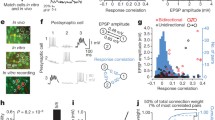Abstract
This paper reports on the consequences of large, activity dependent, synaptic conductances for neurons in a large-scale neuronal network model of the input layer 4Cα of the Macaque primary visual cortex (Area V1). This high conductance state accounts for experimental observations about orientation selectivity, dynamics, and response magnitude (D. McLaughlin et al. (2000) Proc. Natl. Acad. Sci. USA 97: 8087–8092), and the linear dependence of Simple cells on visual stimuli (J. Wielaard et al. (2001) J. Neuroscience 21: 5203–5211). The source of large conductances in the model can be traced to inhibitory corticocortical synapses, and the model's predictions of large conductance changes are consistent with recent intracellular measurements (L. Borg-Graham et al. (1998) Nature 393: 369–373; J. Hirsch et al. (1998) J. Neuroscience 15: 9517–9528; J.S. Anderson et al. (2000) J. Neurophysiol. 84: 909–926). During visual stimulation, these conductances are large enough that their associated time-scales become the shortest in the model cortex, even below that of synaptic interactions. One consequence of this activity driven separation of time-scales is that a neuron responds very quickly to temporal changes in its synaptic drive, with its intracellular membrane potential tracking closely an effective reversal potential composed of the instantaneous synaptic inputs. From the effective potential and large synaptic conductance, the spiking activity of a cell can be expressed in an interesting and simplified manner, with the result suggesting how accurate and smoothly graded responses are achieved in the model network. Further, since neurons in this high-conductance state respond quickly, they are also good candidates as coincidence detectors and burst transmitters.
Similar content being viewed by others
References
Anderson JS, Carandini M, Ferster D (2000) Orientation tuning of input conductance, excitation, and inhibition in cat primary visual cortex. J. Neurophysiol. 84: 909–926.
Azouz R, Gray CM, Nowak LG, McCormick DA (1997) Physiological properties of inhibitory interneurons in cat striate cortex. Cereb Cortex 7: 534–545.
Bernander O, Douglas R, Martin K, Koch C (1991) Synaptic background activity influences spatiotemporal integration in single phyrmidal cells. Proc. Nat. Acad. Sci. USA 88: 11569–11573.
Benardete E, Kaplan E (1999) The dynamics of primate M retinal ganglion cells. Vis. Neurosci. 16: 355–368.
Borg-Graham L, Monier C, Fregnac Y (1998) Visual input evokes transient and strong shunting inhibition in visual cortical neurons. Nature 393: 369–373.
Bressloff P, Coombes S (2000) Dynamics of strongly coupled spiking neurons. Neural Computation 12: 91–129.
Callaway E (1998) Prenatal development of layer specific local circuits in primary visual cortex of the macaque monkey. J. Neurosci. 18: 1505–1527.
Callaway E, Wiser A (1996) Contributions of individual layer 2 to 5 spiny neurons to local circuits in macaque primary visual cortex. Visual Neuroscience 13: 907–922.
De Valois R, Albrecht D, Thorell L (1982) Spatial frequency selectivity of cells in macaque visual cortex. Vision Res. 22: 545–559.
Ermentrout GB (1994) Reduction of conductance based models with slow synapses to neural networks. Neural Computation 6: 679–695.
Gibson J, Beierlein M, Connors B (1999) Two networks of electrically coupled inhibitory neurons in neocortex. Nature 402: 75–79.
Hirsch J, Alonso JM, Reid R, Martinez L (1998) Synaptic integration in striate cortical simple cells. J. Neuroscience 15: 9517–9528.
Koch C (1999) Biophysics of Computation. Oxford University Press, Oxford.
Koch C, Rapp M, Segev I (1996) A brief history of time constants. Cerebral Cortex 6: 93–101.
Lund J (1987) Local circuit neurons of macaque monkey striate cortex neurons of laminae 4C and 5A. Journal of Comparative Neurology 257: 60–92.
Lund J, Wu C (1997) Local circuit neurons of macaque monkey striate cortex neurons of laminae 1 and 3A. Journal of Comparative Neurology 384: 109–126.
Lund J, Yoshioka T (1991) Local circuit neurons of macaque monkey striate cortex neurons of laminae 4B 4A and 3B. Journal of Comparative Neurology 311: 234–258.
McLaughlin D, Shapley R, Shelley M, Wielaard J (2000) A neuronal network model of macaque primary visual cortex (v1): Orientation selectivity and dynamics in the input layer 4Cα. Proc. Natl. Acad. Sci. USA 97: 8087–8092.
Mechler F (1997) Neuronal response variability in the primary visual cortex. Ph.D. diss., New York University.
Ringach D, Hawken M, Shapley R (1997) Dynamics of orientation tuning in macaque primary visual cortex. Nature 387: 281–284.
Roy S, Alloway K (2000) Coincidence detection or temporal integration? What the neurons in somatosensory cortex are doing. Journal of Neuroscience 21: 2462–2473.
Tsodyks M, Sejnowski T (1995) Rapid state switching in balanced cortical network models. Network 6: 111–124.
Usrey WM, Clay Reid R (1999) Synchronous activity in the visual system. Annu. Rev. Physiol. 61: 435–456.
van Vreeswijk C, Sompolinsky H (1996) Chaos in neuronal networks with balanced excitatory and inhibitory activity. Science 274: 1724–1726.
Wielaard J, Shelley M, Shapley R, McLaughlin D (2001) Howsimple cells are made in a nonlinear network model of the visual cortex. J. Neuroscience 21: 5203–5211.
Wiser A, Callaway E (1996) Contribution of individual layer 6 pyramidal neurons to local circuitry in macaque primary visual cortex. Journal of Neuroscience 16: 2724–2739.
Author information
Authors and Affiliations
Rights and permissions
About this article
Cite this article
Shelley, M., McLaughlin, D., Shapley, R. et al. States of High Conductance in a Large-Scale Model of the Visual Cortex. J Comput Neurosci 13, 93–109 (2002). https://doi.org/10.1023/A:1020158106603
Issue Date:
DOI: https://doi.org/10.1023/A:1020158106603




